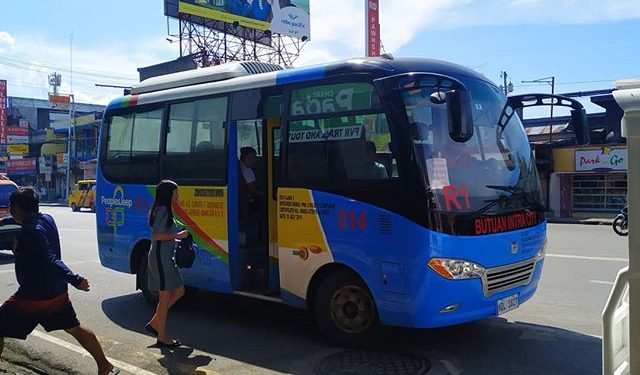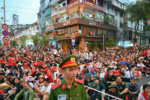Modern PUV’s allowed back on the road

About 300 modern jeepneys (modern PUJ’s) got the green light to start plying Metro Manila roads today to supplement the 3,600 buses already deployed to service commuters in nations capital after almost three months of a paqndemic lockdown.
Some 15 routes will serve 15 areas in Metro Manila as the transition into the “new normal” continues under general community quarantine (GCQ), according to the Land Transportation Franchising and Regulatory Board (LTFRB).
In a memorandum circular dated June 19, 2020, the LTFRB said that modern PUJs or those units that have complied with the requirements set by the Omnibus Franchising Guidelines (OFG) will be allowed to traverse the routes that were initially identified by the board.
The memorandum circular covers “operators of OFG-compliant PUJs that have already consolidated themselves as juridical entities under the Public Utility Vehicle Modernization Program (PUVMP) with valid and existing Certificate of Public Convenience (CPC).”
It also covers operators who “have been granted Provisional Authority (PA) for OFG-compliant PUJs operating in the National Capital Region, and those that will be entering Metro Manila from nearby provinces,” the circular added.
“The resumption of PUJ operations in 15 routes in Metro Manila is part of our calibrated response to restore mass transportation in Metro Manila and in the adjacent provinces as we transition into new normal, taking into consideration the strict health protocols being enforced to prevent the spread of COVID-19,” said LTFRB Chairman Martin Delgra III.
Operators with expired PAs or CPCs who are covered by LTFRB Board Resolution No. 062 dated April 29, 2020 and LTFRB Board Resolution No. 100 dated May 9, 2020 are also covered by the memorandum circular.
With this, LTFRB has allowed 308 OFG-compliant modern jeepneys to ply the initial 15 Metro Manila routes, as follows:
- Novaliches – Malinta via Paso de Blas
- Bagumbayan Taguig – Pasig via San Joaquin
- Fort Bonifacio Gate 3 – Guadalupe-Market Market-ABC Loop Service
- Pandacan – Leon Guinto
- Quezon Avenue – LRT 5th Avenue Station
- Cubao (Diamond) – Roces Super Palengke
- EDSA Buendia-Mandaluyong City Hall via Jupiter, Rockwell
- Divisoria-Gasak via H. Lopez
- Punta-Quiapo via Sta. Ana
- Boni Pinatubo – Stop and Shop, vice versa
- Boni Robinson’s Complex-Kalentong/JRC vice versa
- Nichols-Vito Cruz
- Filinvest City Loop
- Alabang Town Center (ATC)-Ayala Alabang Village
- Vito Cruz Taft Avenue-PITX Loop Service
Several more routes are to be opened for the PUJs on June 24 and 26 to serve other parts of Metro Manila that are adjacent to provinces.
For June 24, 2020:
- Bagong Silang – SM Fairview
- Malanday – Divisoria via M.H. del Pilar
- Parang, Marikina – Cubao
- Eastwood, Libis – Capitol Commons
- Gasak – Recto via Dagat-dagatan
- PITx – Lawton
- Alabang – Zapote
- PITX – Nichols
- PITX – SM Southmall
For June 26, 2020:
- Quirino Highway – UP Town Center
- SM Fairview – Commonwealth via Regalado Ave.
- QMC Loop
- Tikling – Binangonan
- Antipolo – Pasig via East Bank Road
- Rosario – Pinagbuhatan Pasig
- West Avenue – P. Noval via Del Monte
- Biñan – Balibago via Manila South Road
- Tramo – Sucat
- San Isidro – Congressional Junction Dasmarinas
The memorandum further stated that “aside from being compliant to the Omnibus Franchising Guidelines, the modern jeepneys that will be plying routes during the GCQ must also be currently registered and with valid personal passenger insurance policies.”
“The modern jeepneys must also be equipped with GNSS (global navigation satellite system) or global positioning system for proper monitoring of movement,” it added.
Also, “as part of the enforcement of health protocols to prevent the spread of the coronavirus disease (CIVID-19), jeepneys will have to make use of cashless fare payments. Jeepney operators and drivers must make sure that commuters can make use of their mobile apps or contactless smart cards to pay for fares,” the circular read.
It also reminded jeepney drivers, conductors and passengers that wearing of face masks at all times is a must.
It further said that “drivers or operators should provide a disinfecting foot bath for passengers to use before boarding the jeepney, and physical distancing must strictly be observed inside the jeepneys. The passenger load of each jeepney must not exceed 50 percent of its seating capacity (excluding the driver and conductor).”
Passengers, on the other hand, must be one seat apart and that the seats that they will occupy must be properly marked in the vehicle. Also, no standing passengers shall be allowed.
The circular added that “should jeepney operators wish to maximize the 50 percent passenger load of the unit, impermeable barriers to separate the driver’s compartment and between rows of seats that are less than one meter apart, are allowed to be installed.”
Jeepneys plying the identified routes during the GCQ must also properly display the existing fare matrix for the information of the passengers, the circular further read.
Specifically, OFG-compliant non-aircon PUJs will collect a minimum fare of P11 for the first 4 kilometers and P1.50 for each succeeding kilometer, while OFG-compliant airconditioned PUJs will collect P11 for the first 4 kilometers and P1.80 for each succeeding kilometer.
“PUV operators and drivers who fail to comply with any of the aforementioned conditions will be subjected to the imposition of fines/penalties, and/or cancellation or suspension of their certificate of public convenience or provisional authority under Joint Administrative Circular No. 2014-001,” the circular concluded.






